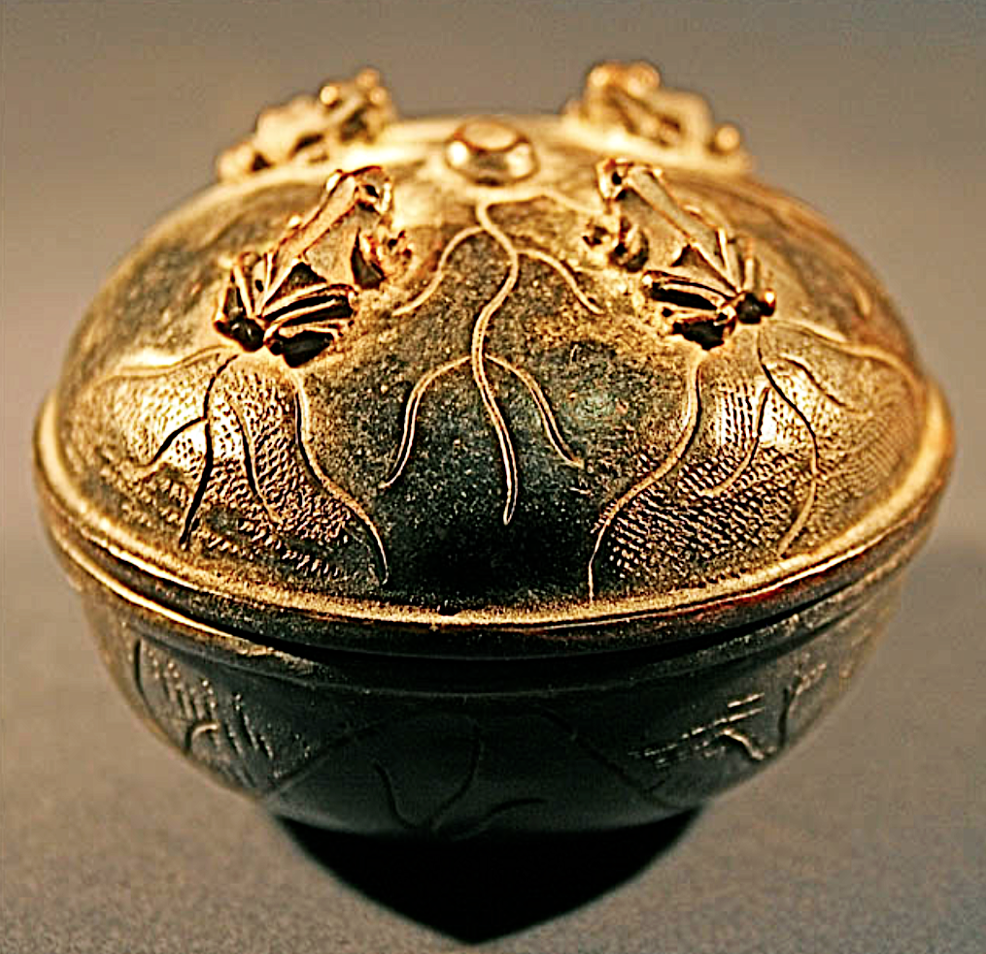

Title: Antique 18th Century Japanese Bronze Four Frog Engraved Pill Box
Shipping: $9.00
Artist: N/A
Period: 19th Century
History: N/A
Origin: Central Asia > Japan
Condition: Museum Quality
Item Date: 1800 to 1930
Item ID: 2728
Super rare old Japanese spectacular container. A charming antique indeed, this small Japanese bronze pill box from the early 18th century features an exquisite design with four frogs adorning the lid. Each box showcases meticulous hand-etching, portraying a delightful combination of floral patterns and frog motifs. Crafted to the highest standards, this pill box emanates charm, character, and quality. Any Collector would be proud to own this unique art piece. Japanese bronze art has a rich and intricate history that spans centuries. The tradition of bronze casting in Japan can be traced back to the Yayoi period (300 BCE – 300 CE), where small bronze items were crafted for utilitarian purposes such as mirrors and weapons. However, it was during the Nara period (710–794) and the Heian period (794–1185) that the art of bronze casting began to flourish. In the late Heian period, Buddhist sculptures and temple bells became prominent examples of Japanese bronze art. Skilled artisans employed the lost-wax casting technique, allowing for intricate details and expressive forms. These pieces often served religious and ceremonial purposes, contributing to the grandeur of Buddhist temples. The Kamakura period (1185–1333) marked a shift in the focus of bronze art from religious to secular subjects. With the rise of the samurai class, demand for decorative items, armor, and weaponry increased. Japanese sword fittings, known as tsuba, started to showcase elaborate bronze craftsmanship. The Muromachi period (1336–1573) saw the emergence of tea culture, influencing the production of bronze incense burners, tea kettles, and other utensils. Artisans like the famed Myochin family specialized in crafting intricate armor and household items. During the Momoyama period (1573–1603) and into the Edo period (1603–1868), peace and stability allowed for artistic refinement. Japanese bronze artisans created exquisite sculptures, vases, and ornamental pieces. Notable artists like Ono Sadakatsu and Suzuki Sadatsugu produced masterpieces, often commissioned by daimyos and wealthy merchants. The Meiji period (1868–1912) witnessed a significant transformation as Japan opened up to the world. Western influences and industrialization impacted artistic styles, leading to a fusion of traditional Japanese craftsmanship with modern techniques. Bronze sculptures and decorative arts gained international acclaim during this era. In the contemporary period, Japanese bronze art continues to evolve, blending traditional techniques with innovative designs. Artists explore a wide range of themes, from traditional motifs to avant-garde expressions, contributing to the ongoing legacy of Japanese bronze craftsmanship.
Our expertise lies in curating high-end luxury fine art and collectibles sourced from private estates. We excel in discovering and acquiring a diverse range of items, including contemporary, vintage, antique, and collectible pieces from around the world. Through individual craftsmanship, we revive these forgotten relics, infusing each with a renewed narrative. Dealers, galleries, and private collectors are invited to securely register and engage in the purchase of these unique treasures.
Link: http://en.wikipedia.org/wiki/Bronze
Bronze is widely used for cast metal sculpture . Common bronze alloys often have the unusual and very desirable property of expanding slightly just before they set, thus filling in the finest details of a mould. Bronze has resistance to corrosion by sea water along with several bronze alloys. Bronze also has very little metal-on-metal friction, which made it invaluable.